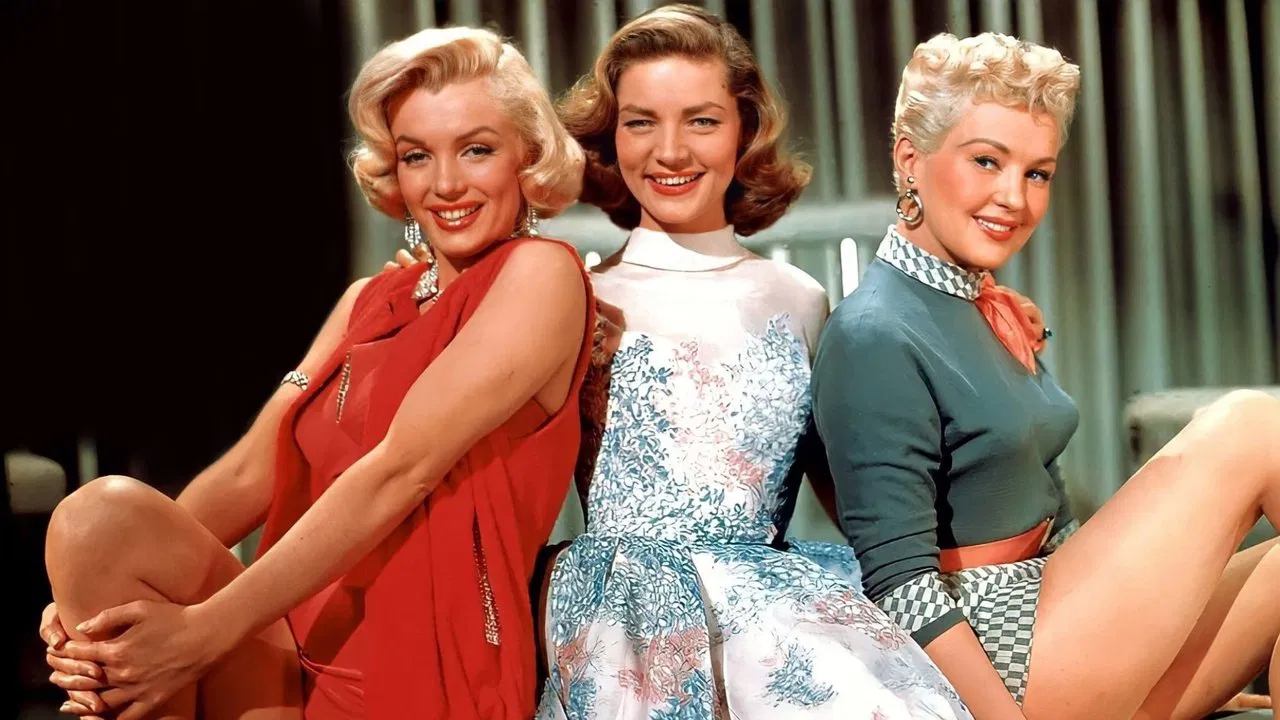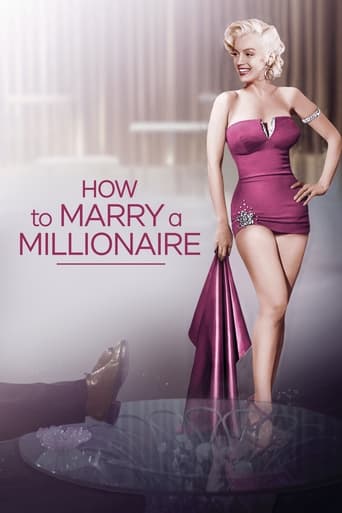

Far from Perfect, Far from Terrible
... View MoreThis story has more twists and turns than a second-rate soap opera.
... View MoreIt’s not bad or unwatchable but despite the amplitude of the spectacle, the end result is underwhelming.
... View MoreOne of the film's great tricks is that, for a time, you think it will go down a rabbit hole of unrealistic glorification.
... View MoreA movie that just oozes Hollywood class and quite frankly, it needs nothing more. A very odd beginning with a guy conducting a full orchestra for well over 5 minutes. But this is all about the three leading ladies. Bacall is smokin'! Monroe is ditzie, seductive and shows some glorious comic timing and business with her glasses. Grable is just plain delightful. To repeat myself, this is Hollywood all over but with a lovely light touch.
... View MoreCopyright 4 November 1953 by 20th Century-Fox Film Corp. New York opening simultaneously at the Globe and Loew's State: 10 November 1953. U.S. release: November 1953. London opening at Odeon Marble Arch. U.K. release: March 1954. Australian release: 21 January 1954. Sydney opening at the Plaza (ran 12 weeks at this 1,500 seat cinema, four sessions a day). 8,607 feet. 96 minutes.SYNOPSIS: Three attractive but impoverished gold-diggers set out to trap millionaire husbands. Two of them succeed, but more through good luck than calculated design.NOTES: "Loco" opened on Broadway at the Biltmore on 16 October 1946 and closed after only 37 performances due to extremely unfavorable reviews. Jean Parker (in her Broadway debut) played the model with a heart of gold and Jay Fassett the philandering businessman. These roles were played in the movie by Betty Grable and Fred Clark. The play was produced and directed by Jed Harris. On the other hand, "The Greeks Had a Word for It" was a reasonable success. The play opened on Broadway at the Harris on 25 September 1930 and ran 224 performances. Dorothy Hall, Muriel Kirkland and Verree Teasdale played the three gold-diggers, opposite Hardie Albright, Frederic Worlock and Ernest Glendinning. The play was produced and directed by William Harris, Jr. In 1932 producer Sam Goldwyn changed the title slightly to "The Greeks Had a Word for Them" and starred Ina Claire, Joan Blondell and Madge Evans in a movie directed by Lowell Sherman from a screenplay by Sidney Howard, no less. (Betty Grable had a minor role as a showgirl). This theme was then used countless times in the 30s, 40s and early 50s, most notably in the Gold-Digger series of musicals produced at Warner Brothers, Andrew Stone's "The Bachelor's Daughters" and in such Fox variations as "Three Blind Mice", "Moon Over Miami: and "Three Little Girls In Blue". Both Le Maire and Travilla were nominated for an Academy Award for Best Color Costumes, but lost out to Le Maire's own "The Robe" in which he collaborated with Emile Santiago. Fox's second CinemaScope feature. Negative cost: $2.5 million. Initial domestic rental gross: $7.3 million. U.K. rentals: $2.5 million. Australia: $1.7 million. Fox's top-grossing release worldwide for 1954. The title, "How To Marry a Millionaire" was purchased from Doris Lilly, author of a real-life guide to this subject, for the incredible sum of $50,000. Marilyn Monroe, Best Actress — Photoplay Gold Medal Award.COMMENT: "How To Marry a Millionaire" shows its age, but still holds up rather well. Naturally, it bends over backwards to embrace the novelty of CinemaScope. After a curtain-raiser with the 20th Century-Fox Symphony Orchestra designed to show off the process' stereophonic sound, CinemaScope takes us on a travelogue excursion to New York City. We also see and hear airplane propellers in close-up, we thrill to an airport landing, we travel by car across George Washington Bridge, by train to Maine, and share a buggy ride in the high snow country. There's also a fashion show. I mean when you have three lookers like Monroe, Grable and Bacall, why waste them? A pity though that there's so much dull talk and that Fox resisted what must have been an obvious temptation to turn the movie into a musical. Many musical opportunities are passed up. Maybe it was thought the picture already had enough going for it, though one could question that assumption. Aside from his spacious use of CinemaScope, with characters often neatly lined up across the whole expanse of the screen, Negulesco's direction is pretty routine. Although it's full of inside jokes, the script is not as clever or witty as Johnson and Negulesco obviously think it is. It's also hard to credit such plot devices as cold Bacall falling for a gauche, charmless eccentric like Cameron Mitchell — and preferring him to William Powell (whom it's always a pleasure to see, even when cast in such a thankless role as here). Mr. Calhoun is also a waste of time, but Bacall, Wayne, MM and Grable are a delight. Of course we see less of MM than her top billing gives us a right to expect. Stunningly costumed throughout, she plays with considerable flair and finesse, and displays a naive charm that is quite appealing. (Unlike some of MM's other directors, Negulesco permitted MM's dramatic coach, Natasha Lytess, to actually coach her on the set.)The color photography of course, as in all early CinemaScope productions, is quite grainy, but that technical deficiency is partly redeemed by that great Fox sound recording - best in the industry!
... View MoreSometimes I'll watch a film like this and wonder if it would or could be made today. I saw this one on Turner Classics as one of the essentials, with host Robert Osborne and guest Drew Barrymore lending their comments on the picture. It was almost comical listening to Barrymore try to walk a fine line between enjoying the story and being careful not to antagonize her feminist side over the theme of gold digging women on the prowl to snag a rich husband. I wonder if she caught any grief over that one from Cameron Diaz.Like so many of these early to mid Fifties flicks, I find myself on the fence regarding their appeal. For me the story was so-so, largely predictable, and even though billed as a comedy, I didn't find myself in on the joke for the most part. Marilyn Monroe's eyesight gimmick was tiresome and didn't come across very believably, and Lauren Bacall, only a decade since debuting in "To Have and Have Not", seemed to be older than her real age of twenty nine. Betty Grable was obviously ready to pass the baton to her co-star Monroe as filmdom's next glamor queen. I don't know, maybe it's just me but I didn't detect the camaraderie among this trio and that took something out of it for this viewer.There was one good line though for this Bogart fan. I got the biggest kick out of Bacall's comment about the African Queen guy. Grable got one in on Harry James too, so that was all cleverly done. Over all I'm satisfied I got to catch this one since it's one of the early Fifties standards that everyone should catch, but now that I've done it I'll be happy to move on.
... View MoreWhew! A cast full of the finest talent and yet this movie is so tedious it is hard to slog through! The vacuous premise of the film is partly to blame - the idea of three women seeking men solely for their money is deeply offensive to say the least although this is a sin society tends to allow them. This idea, however, could have worked in a comedy - and this purportedly was a comedy. But it was such a snoozer it did not come across as funny in any way shape or form. It just came away as a B or C movie about worthless and shallow women. Strange that Robert Osborne, the esteemed movie expert and historian, liked this film and felt Lauren Bacall stole the film. She wore a perennial scowl (one that made her look ugly, if you can imagine that!) and was the most unlikeable of all the characters - constantly telling the man she eventually settles down with, "I never want to see you again!" That, I guess, was meant to be funny, but it only came across as cold. William Powell, with a minor role, is his endearing self but is handicapped by an unimaginative script that relegates him to an almost irrelevant character. What a waste of talent! Marilyn Monroe arguably is the only one who still manages to shine on some level, putting on a comic performance that displays her comedic talents at their best...yet even that effort falls short because the movie sucks the oxygen out of every scene it's so dull. Nothing is believable so when these unsympathetic characters manage to marry by movie's end, you could care less. There's certainly no reason to celebrate. These marriages seem motivated only by shallow desires and intentions. Therefore one almost cringes at the end, out of embarrassment for the great actors whose presence was wasted in this poor excuse for a film. Really, in retrospect, it appears to have been more a vehicle to show off three hot babes and sell tickets on their sex appeal than anything else. And so if you're a huge Marilyn fan - and possibly even a Betty Grable fan - you might enjoy this, for her attractiveness and sparks of true acting talent. Grable still looks good in her late '30s and so big fans of hers might also want to see this film on that one level - the level of curiosity and fandom, not of the true movie connoisseur. Oh - and David Wayne fans will like his comic vignettes. He also manages to survive the film unscathed, like Marilyn. The only laugh in this film, by the way, is actually pretty funny. (It's a throwaway line by Bacall about her real-life husband Humphrey Bogart (who fortunately wasn't in this train wreck of a film), which I won't spoil here.)
... View More